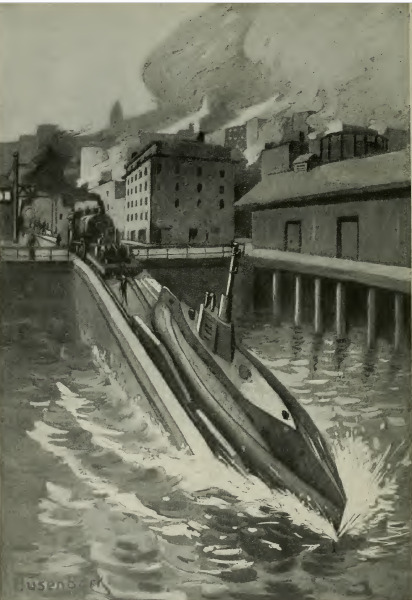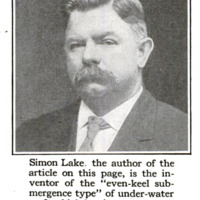-
Titolo
-
Undersea Fighting of the Future. I.-Mobilizing Submarines on Rails
-
Article Title and/or Image Caption
-
Undersea Fighting of the Future. I.-Mobilizing Submarines on Rails
-
Caption: Simon Lake, the submarine inventor, suggests that we could mobilize two-hundred-ton submarines by rail. "The railway tracks would be continued down under the water as a submarine railway at such points as the government might desire. It would be necessary only to back the truck and submarine down into the water until the submarine floated"
-
extracted text
-
I FIRMLY believe
destiny of the
submarine is to stop
all future maritime
wars between coun-
tries. A tremendous
power for destruction,
the submarine is in it-
self useless for purposes
of invasion. The mo-
ment the submarine
becomes visible it be-
comes vulnerable. Its
function, therefore, is
to lie in wait and at-
tack unawares. All
students of warfare
must now admit that
it is manifestly impos-
sible to send an army
across the sea with big
guns and troops and to land them, if
submarines are on watch. I believe all
engineering experts must also admit that
when the proper motive power for sub-
marines is evolved, a motive power which
will give the submarine the speed of a
surface ship, then mer-
chantmen cannot carry
on commerce on the
high seas except by
mutualagreementequi-
table to all nations.
And I believe this will
hasten the day when
each country will con-
sent to agreements to
“‘do unto others as they
would be done by.”
If, in time of nation-
al differences, it were
possible for each
country to encircle it-
self with a zone ten
miles in width, to pass
which would be sure
death, it would not be
long before quarreling
countries would make up their differ-
ences. If our country had sufficient
submarines to protect its coast linc
and to establish such a similar zone,
an offensive war would be rendered
unnecessary.
Last year Congress made an appro-
priation calling for 25-knot submarines,
to cost not more than $1,500,000 each.
1 saw this reported in the newspapers
and 1 immediately wired the Depart-
ment that it was impossible to secure 25-
knot boats for less than about two-and-
a-quarter million dollars each, and I
later advised that it would then probably
take several years to develop a suitable
engine. The largest submarine engine
of which I know is one of 1300 horse-
power, completed in Italy for one of the
large German boats just at the beginning
of the war.
As it would probably require about
10,000 horsepower to attain twenty-five
knots, Congress hardly realized how
stupendous was the problem of produc-
ing at a single step a boat capable of
traveling nearly twice as fast as the
best underwater vessel of the day. No
wonder there were no bidders for a
25-knot boat.
While it was impossible, even with
unlimited money, in the present condi-
tion of internal combustion engineering,
to develop a 25-knot submarine boat
quickly, it is possible to get quickly a
large number of 50-knot submarine boats
of small size, which for the same expendi-
ture would prove many times more
effective in warding off an attack than
the larger boats. I refer to what I call
“amphibious submarines;” that is, sub-
marines of about two hundred tons dis-
placement, which could be hauled on
special railway trucks from one point of
the country to another at a speed of
fifty knots per hour, with crews, stores,
equipment, all on board. The railway
tracks would be continued down under
the water as a submarine railway at
such points as the Government might
desire. It would be necessary only to
back the truck and submarine down
into the water until the submarine
floated. Her commander would only
need to give the bell and she would be
off. Such boats could probably be
built for three hundred thousand dollars
each to make ten knots on the surface
and about eight submerged. It would
be possible to get six or eight such boats
for the cost of one twenty-five-knot boat
and cover six to eight times as much
territory. A torpedo fired from a small,
inexpensive boat is just as effective as one
fired from a large, expensive boat. The
small boats could make the trip from
New York to San Francisco in four days,
New York to Boston in five hours, New
York to New Orleans in thirty-six hours,
in perfect safety, while a modern large
submarine, under war conditions, could
probably not make the trip at all, except
as a slow-going surface boat, liable to
capture or destruction. One hundred of
these amphibious submarines could be
quickly turned out by the various ship-
yards throughout the country, and it
would also be possible to get engines
quickly for them; the power required
permits of using sizes of engines that
have already been developed by several
concerns. Such a system of coast
protection would enable the quick mobil-
ization of a large number of submarines
at any threatened locality, for harbor or
coast defense purposes. Of course it
would be advisable to have a large
number of submarines for off-shore work
or to patrol the coast where distances
between ports or harbors would be too
great for the smaller craft.
Many disadvantages accompany the
use of the storage battery. It is very
heavy for the horsepower energy it |
carries. It is also bulky, so that only |
sufficient energy may be carried to |
propel modern submarines at about
eleven knots per hour for one hour,
about eight knots per hour for three
hours, or at about five knots per hour
for twenty hours. This means that when |
the energy is exhausted the submarine |
must ascend to the surface or secure |
surface connection in order to obtain
air to enable her engine to be run to |
recharge her batteries. This is likely to |
prove her undoing, as the noise of her
internal cumbustion engines in charging,
can, with a proper receiver, be heard
many miles, and would direct an cnemy |
surface boat or submarine to her. There- |
fore, before the submarine can become
invulnerable, she must become capable
of operating without sound. If it were |
possible to produce some sort of primary |
battery whereby energy-producing ma--
terial could be put into the battery like |
coal into a furnace, it would be ideal for
submarine torpedo-boat use, and the |
submarine would then become invincible. |
-
Autore secondario
-
Simon Lake (inventor and writer)
-
Lingua
-
eng
-
Data di rilascio
-
1916-06
-
pagine
-
803-804
-
Diritti
-
Public Domain (Google digitized)
-
Archived by
-
Filippo Valle
-
Alberto Bordignon (Supervisor)




